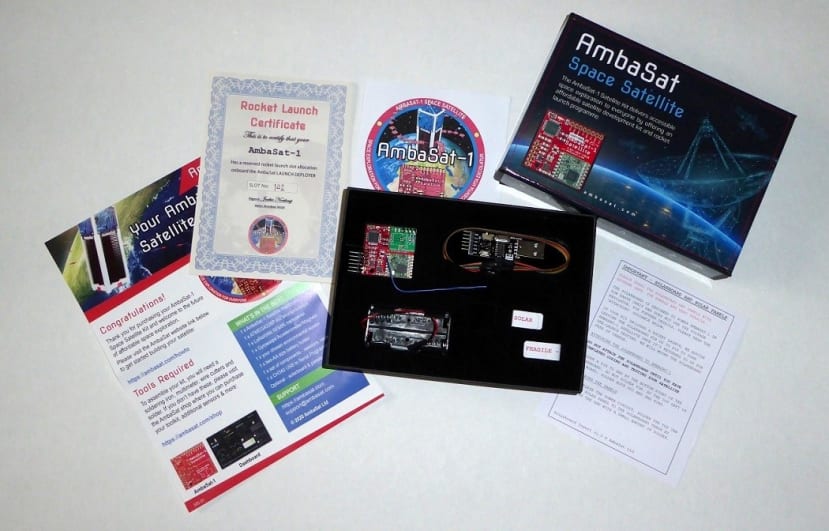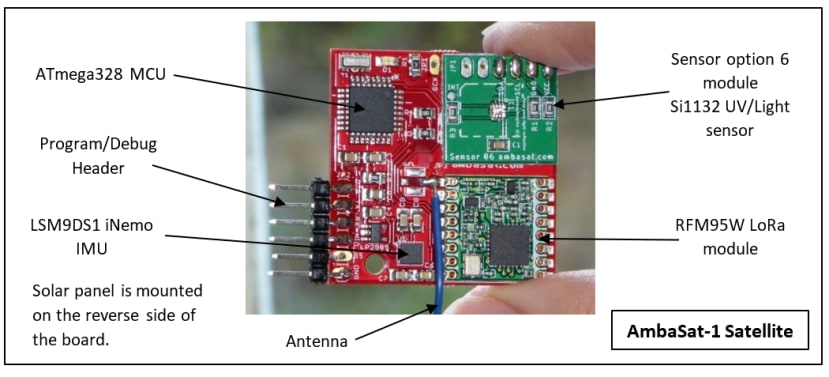My First Steps into Space
Follow articleHow do you feel about this article? Help us to provide better content for you.
Thank you! Your feedback has been received.
There was a problem submitting your feedback, please try again later.
What do you think of this article?
OK, that’s a bit of an exaggeration, but the AmbaSat satellite kit I backed on Kickstarter last year has finally arrived – complete with a launch-slot certificate. In June 2019 I published an article on DesignSpark with the title New Constellations in the Sky. It was written in response to the news that SpaceX had just launched the first batch of a possible 21000 satellites to provide worldwide Internet access. The Starlink project is not the first use of satellite constellations: think GPS (SatNav) or the less well-known Iridium system. That article summarises most of the pros and cons of filling the skies with even more hardware at a time when there is a great deal of concern over Space junk or debris. I won’t go over those arguments again here. Suffice to say that the AmbaSat ‘constellation’ I talked about in my article and subsequently backed, will only stay in Low Earth Orbit (LEO) for between three weeks and three months, before succumbing to atmospheric drag and burning up.
A satellite for the masses
A few years ago, only wealthy governments and large organisations could afford the massive costs associated with putting anything in Earth orbit let alone sending spacecraft to another planet. All that changed with the development of tiny CubeSats and their even smaller brethren: Pocketqubes. Much cheaper but still out of reach for most individuals, CubeSats have found a niche in education with universities building them for research on limited budgets. Individual launch costs are much lower because one rocket can carry many CubeSats into orbit. Recently, miniaturisation has progressed further and we now have the SpriteSat, basically just a square PCB with a wire antenna. The ability of a bare board to survive in Space long enough to communicate useful data with the ground was demonstrated by the KickSat-2 project in 2019. Now we have the concept of a CubeSat as a SpriteSat ‘dispenser’, placing perhaps 200 of these ‘picosatellites’ into Earth orbit in one go. No surprise then that the cost of launching your very own satellite has dropped into the high-hundreds of GBP zone. Enter the AmbaSat project.
Satellite Communications
There is no point in sending a satellite into Earth orbit unless you can communicate with it. Unless of course it’s a fully autonomous doomsday weapons platform. Assuming you haven’t managed to squeeze that particular functionality onto a 3.5cm square PCB, then a more practical application is a sensor platform relaying cosmic/atmospheric data to a ground station. Reliable communication with a receiver on the surface is not going to be easy though:
- The satellite is moving at about 27000 km/h and completes a single orbit around the equator every 90 minutes at a height of about 240km.
- A ground receiver will only have the satellite in view for about 10 of those 90 minutes as it travels across the sky from horizon to horizon.
- Only a receiver on the equator will see it pass directly overhead. It appears lower in the sky at higher latitudes. At each pole, it never even gets above the horizon!
In order to get the most out of this kind of comms channel it’s normal to use high-gain steerable antennae that follow the satellite across the sky. These antenna types, usually parabolic dishes or helical-wire, trade wide-directivity for high-gain which is why they have to track the satellite accurately. A simple fixed dipole or monopole is nearly omnidirectional but has very little gain. The problem for us is that our tiny satellite only has room for a quarter-wavelength monopole, in practice a bit of stranded wire 86mm long sticking up at right-angles to the PCB surface. (The wavelength λ of the carrier frequency 868MHz is 345mm, a quarter of which is 86mm.) It has a gain of about +5dB.
The ground station could have a much more elaborate antenna but this supposed to be budget-constrained project which precludes steerable antennae. Fortunately, RF radio chips based upon a new carrier modulation technique appeared on the market a few years ago. The technique, called Chirp Spread Spectrum (CSS), originally devised to increase the detection range of radar equipment was adapted to do the same for radio communication. It was given the name LoRa, for Long Range. And this is what the AmbaSat project is all about: proving that a swarm of tiny cheap satellites can communicate successfully with a network of equally low-cost ground stations, ultimately delivering their data to users via the Internet.
The Link Budget
The link budget is a simple formula that allows the designer of a comms link to juggle the values of parameters such as transmitter power, transmitter and receiver antenna gains, something called Free-Space Loss and receiver sensitivity. If they can ‘balance the budget’ using commercially available hardware, then there is a very good chance the comms link will actually work. Arranging the link budget formula to tell us what the receiver sensitivity needs to be, given the other parameters, we get this:
RxS = TxP + GR + GT + LFS + FM = -139dBm
where RxS = Required Receiver Sensitivity (dBm)
TxP = Transmitter Power (+20dBm or 100mW)
GT = Transmitter Antenna Gain (+5dB monopole)
GR = Receiver Antenna Gain (+5dB monopole)
LFS = Free Space Loss (-139dB for 868MHz carrier over 240km)
FM = Fade Margin (-30dB estimated worst case)
Checking with the Semtech SX1276 LoRa transceiver chip datasheet reveals that it can be set up to have a receiver sensitivity of at least -139dBm. Job done! But high sensitivity is achieved at a price – much reduced data rate. Given the numbers above, this link will operate down in the hundreds of bits per second. Of course, these are just my numbers: the AmbaSat designers may decide for example that the large Fade Margin is unjustified. Reducing this value would improve the receiver sensitivity and allow a faster data rate.
I should say at this point that none of this ‘techy stuff’ is needed to build and program the AmbaSat satellite kit, but if you want to know more about link budgets, how LFS is calculated or even why decibel units (dB) are used, then check out my article on RF communication.
The effect of an (almost) spherical planet on communication
A lot of fuss has been made in the literature about how LoRa has massively improved the range of RF transceivers working in the Industrial, Scientific, Medical (ISM) license-free band. It’s true that the huge redundancy resulting from using CSS modulation greatly improved receiver sensitivity and hence increased range over that of conventional modulation schemes such as Frequency Shift Keying (FSK). Datasheets usually refer to maximum LoRa ranges in the region of 15km. Hang on. The AmbaSat system is supposed to work over at least 240km. How is that possible? The answer is simple: the Earth is round and LoRa is a terrestrial communication system designed to connect two points on the surface. UHF frequency radio waves like those in the ISM band travel in straight lines so a transmitter and receiver must be in line-of-sight of each other. In other words, communication cannot take place beyond the horizon which at sea-level is only about 5km away. Neither increasing the transmitter power nor improving receiver sensitivity will make much difference. However, mounting your equipment on the top of tall buildings or hills will result in much improved range. Needless to say, engineers have been keen to find out just what the limits are, and have beamed signals successfully between the tops of Swiss mountains over 100km apart. To do this with pre-LoRa modulation schemes would require a beefed-up transmitter and a very high-gain, but highly directional antenna at each end. A LoRa-based system manages with the same weedy signal power and antennae used at sea-level. It wasn’t long before thoughts moved towards the possibilities of satellite communication. A UK-based company, Lacuna Space has already demonstrated that LoRa works in Space and is looking to set up a commercial Internet of Things network based on satellites.
The AmbaSat-1 Kit
It’s been over a year since I signed up to the AmbaSat Kickstarter campaign and at last, despite a global pandemic my satellite kit with launch certificate has arrived. In the box is a fully-assembled satellite: I didn’t fancy attempting Space-quality surface-mount soldering. The incredibly fragile solar-panel is not soldered on and it’s recommended that you let them deal with that when it and the board are returned to AmbaSat for checkout and launch. I notice the second-launch units are supplied mostly-assembled apart from the LoRa and optional sensor modules. These SMT boards are easy to solder, unlike the chips. A battery box is included for testing the unit before its solar panel is attached.
Programming
The kit includes a USB-UART bridge module for connecting the programming/debug header to a USB socket on a PC. For compiling source code and moving the resulting object code into the microcontroller’s Flash program memory, two options are available: Microsoft’s Visual Studio Code software with the PlatformIO extension, or the rather simpler Arduino IDE with which many people will already be familiar. Both are free to download. AmbaSat will be supplying the source code so there’s no need to panic, but if you’re keen to have a go developing satellite software yourself then you may do so. It will be checked thoroughly before launch though!
Launch
The Kickstarter units are booked onto an Interorbital Systems NEPTUNE rocket, hopefully heading into orbit next year. The second group being formed now will probably use one of the first vehicles from the UK-based Skyrora company. The rocket carries a single CubeSat dispenser into orbit containing up to 200 SpriteSats. It ejects each AmbaSat at fixed intervals causing them to spread out in all directions – in the plane of the orbit – with the solar panels facing away from the Earth.
Getting the data back
As they whizz round the globe, the satellites will talk to LoRaWAN Gateways below belonging to The Things Network (TTN). A gateway is an inexpensive box of electronics which interfaces a LoRa receiver to the Internet. It forwards your sensor data to a ‘Dashboard’ display program running on your PC at home. There are thousands of these gateways distributed around the world, so wherever it is, providing the solar panel is in sunlight, your satellite can get its precious data to you wherever you are.
The Next Steps
There’s a long way to go before data starts streaming down from a constellation of AmbaSat SpriteSats. At the time of writing even the rockets have not flown yet! Before the appropriate official licences for deployment can be issued, various technical problems need to be resolved. For example, some countries such as the USA don’t permit use of 868MHz over their territory – 915MHz must be used instead. Fortunately, the LoRa module can handle both. In the meantime, what can be done with a grounded satellite? Quite a lot actually. AmbaSat-1 can be viewed as a self-powered, wireless remote sensor for the Internet of Things (IoT) using its LoRa link to transfer readings to the Internet. The only snag is that if the nearest gateway is more than about 15km away that link may not be possible for the reason given above. In that case, you can set up your own: a plug and play gateway can be obtained for about 70GBP: For example (192-7593) for use in the UK.
If you're stuck for something to do, follow my posts on Twitter. I link to interesting articles on new electronics and related technologies, retweeting posts I spot about robots, space exploration and other issues.





